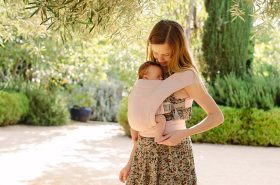
You have been carrying your baby for nine months. They have constantly heard your heartbeat and felt your closeness. They have felt safe and secure. So it’s no wonder that they need this closeness after they arrive in the world. With a baby carrier or wrap, you can give your baby exactly this feeling of safety and security. This allows them to relax and so they are more likely to fall asleep. At least in the first few months of life.
Have you ever asked yourself though, if it’s safe for your baby to sleep in a baby carrier? Or should you wake your baby when they fall asleep in it? Our babywearing expert Katrin Ritter has the answers and gives you important babywearing tips for sleeping in a baby carrier in today’s blog.
Is it safe for baby to sleep in a carrier?
There are actually no studies on this. What is clear, however, is that humans are a carrying species by nature and our babies have always been carried. Evolution has therefore designed them to fall asleep there from time to time. It is important that you always use the baby carrier correctly: your baby’s airways must always be clear and you should be able to see your baby’s face. Never cover your baby completely with a wrap or the hood of the carrier and always ensure that there is sufficient air circulation. In addition, your baby’s back must be well supported according to their age so that they don’t slump down in the carrier, as this can also compromise their airways. Please keep checking the fit of the carrier and your baby and adjust the position if necessary.
Is it better for babies to sleep in a carrier or in bed?
The official recommendations on sudden infant death syndrome state the safest way for your baby to sleep is on their back on a firm, flat, waterproof mattress that is clear of all obstructions such as loose blankets, pillows, cuddly toys etc. There are those who are concerned with the risk of suffocation in a baby carrier or sling when used incorrectly. At the same time, there are also those who say that sleeping in a baby carrier is preferable because you can watch your baby the whole time and it also gives them safety and security which enables them to relax and sleep.
The truth is probably somewhere in between. It is generally advisable to find a good mix between naps in bed and those in the baby carrier if you can. Basically, newborns sleep a lot. If a baby is safely and securely placed in your baby carrier, you can not only keep a constant eye on their breathing, but you can also reduce the risk of your baby getting a flat spot on the back of the head. You also have more time to interact with your baby in the carrier and co-regulate them. And you are more flexible when it comes to getting things done in the meantime.
If your baby takes a nap in the carrier in the early evening – before being put to bed later for the night’s sleep – this can even help your little one to fall asleep more easily at night and find a good sleep rhythm. Why is this the case? The close contact with you helps them to stay calm and establish a good sleep routine.
How often and for how long can a baby sleep in a baby carrier?
Baby can definitely sleep in a baby carrier as often and for as long as necessary. With the small restriction that night-time sleep should take place in their normal sleep space with the usual safe sleep considerations.
If you are wondering whether your baby generally sleeps too much or too little, then take a look at your little one’s sleep requirements. This changes constantly during the first months and years of life. However, the data you find in sleep requirement tables are only guidelines, as every child is of course individual. But in most cases, they fit quite well and give you a good orientation. You can also find more useful tips on getting baby to sleep and baby sleep in general on our blog.
Can the baby only sleep in the inward-facing mode or also on the back?
The back carrying method is not so suitable for baby sleeping. You simply don’t have a good view of your little one when they are on your back. Even if they already have good head control, this will rapidly deteriorate if your little one suddenly nods off. We therefore recommend that you switch your baby to an inward-facing carry position on your front as soon as they become sleepy or start nodding off. This way, your child can sleep safely and in a familiar environment. Your child should also never sleep while facing outwards as this can compromise their airways. As with a back carry, you should turn them back around to face you if they start to get sleepy while outward facing.
Is it okay if my child almost always sleeps in the baby carrier?
From a biological point of view, this is also exactly as it should be: The baby squatting against their parents’ body in general is a completely natural position (after all: the human being is a baby carrier!). Babies grow up on their mother’s/parents’ bodies, they are dependent on them and therefore it makes sense by nature to carry them close to you.
Of course, the carrier is not just for your baby to sleep in. It’s also fun when your baby is awake, as they want to discover more and more as they get older. If they need a rest they can of course also take a little nap every now and then. This way, your baby spends even more time with you or another carer. For babies who suffer from reflux or colic, the baby carrier can also provide a helpful and supportive sleeping position.
Should I wake my baby if they fall asleep in the carrier?
Please leave your baby to sleep if there is no specific reason to wake them. Especially in the first few weeks, you should only wake your baby if your doctor or midwife advises you to feed them at a certain rhythm or if there are other medical reasons. Babies generally only sleep for short periods anyway, as they have a different sleep rhythm to adults.
In fact, short naps in the baby carrier actually help your baby because they ensure that your baby is not overtired as it can rest at any time. When a baby is overtired, the stress hormone cortisol is released. This makes it harder for your little one to get a good night’s sleep and wakes up more often overnight. And you definitely don’t want that. Relaxation is therefore the be-all and end-all.
Some also say that babies are better able to distinguish between short daytime naps and longer night-time sleep if the former takes place in the carrier and the latter in bed. Babies also tend to experience only positive feelings in the carrier: most of them feel safer, more secure and much more content so close to mum or dad’s chest. As a result, they generally associate sleep with something positive. And all of this can ultimately contribute to them sleeping longer and better or developing better sleep routines.
Can I sleep when my baby is sleeping in the carrier?
It’s perfectly understandable if you want to lie down for a while while your baby sleeps in the carrier. That is also tempting. BUT: please don’t do it! Dr Gina Posner is a paediatrician in California and explicitly points out that it can be dangerous for your baby. She says: “The problem with co-sleeping with your baby in a baby carrier is that their head could fall forwards and their breathing could be restricted. It can even suffocate itself in the carrier.”
If you take a look at the T.I.C.K.S. rule for safe babywearing, it goes without saying that it is not recommended for you to fall asleep with your baby in the carrier. It is advisable to keep a constant eye on your baby’s position and correct it if necessary. Your entire musculature also relaxes when you sleep. This means that your own posture changes enormously. This could also lead to you unknowingly putting your baby in danger.
Which carrier is best for baby sleeping?
The answer is quite simple: any that fits! The only important thing is that the carrier grows with your baby and is ergonomic. Your little one must be well supported from head to toe and have a relaxed posture. For newborns, stretchy wraps such as our Ergobaby Aura are particularly soft and stretchy, which many parents and their babies simply love. Newborn carriers such as the Ergobaby Embrace are the ideal middle ground between this and a more structured carrier. They combine the advantages of a baby carrier – intuitive and super easy to put on thanks to the predetermined shape and three buckles – with the advantages of a wrap – airy, super soft and stretchy. Then as your little one grows, one of our more structured carriers like the Aerloom, Adapt, Omni or Away carriers all offer plenty of support while little one snoozes.
Babywearing tips: baby sleep in the baby carrier – it’s all in the mix
Your baby loves to sleep close to you. And you probably love to feel your little one close to you. So feel free to go for it, but pay attention to the things mentioned above regarding position, duration, timing etc. Then nothing will stand in your way. We hope we have been able to answer your most pressing questions about baby sleep in a baby carrier or sling. If you have any other questions about baby sleep, then take a look at the other blog posts on this topic.



